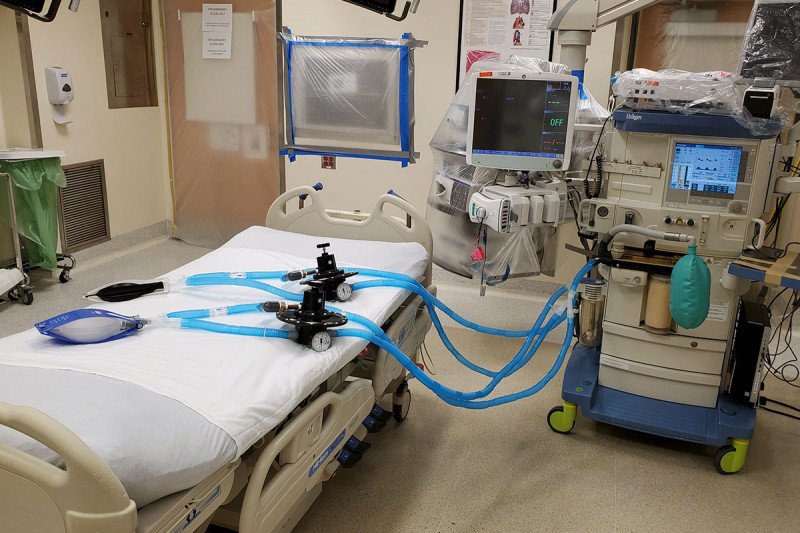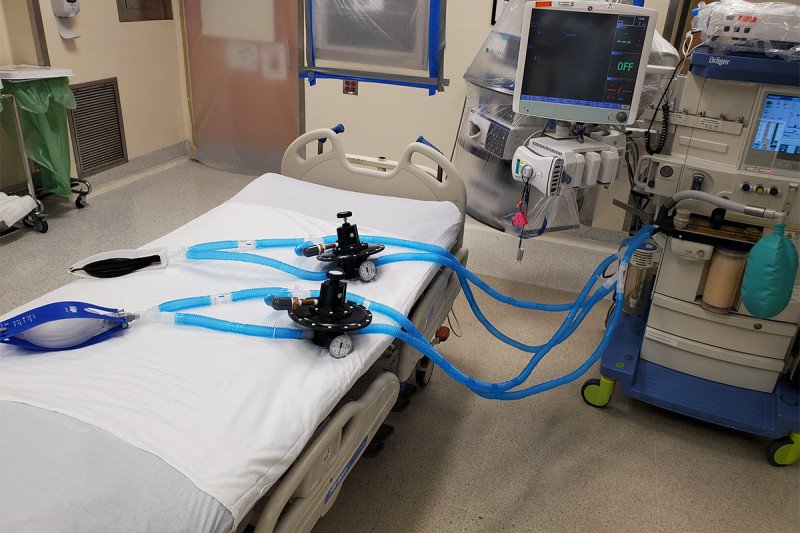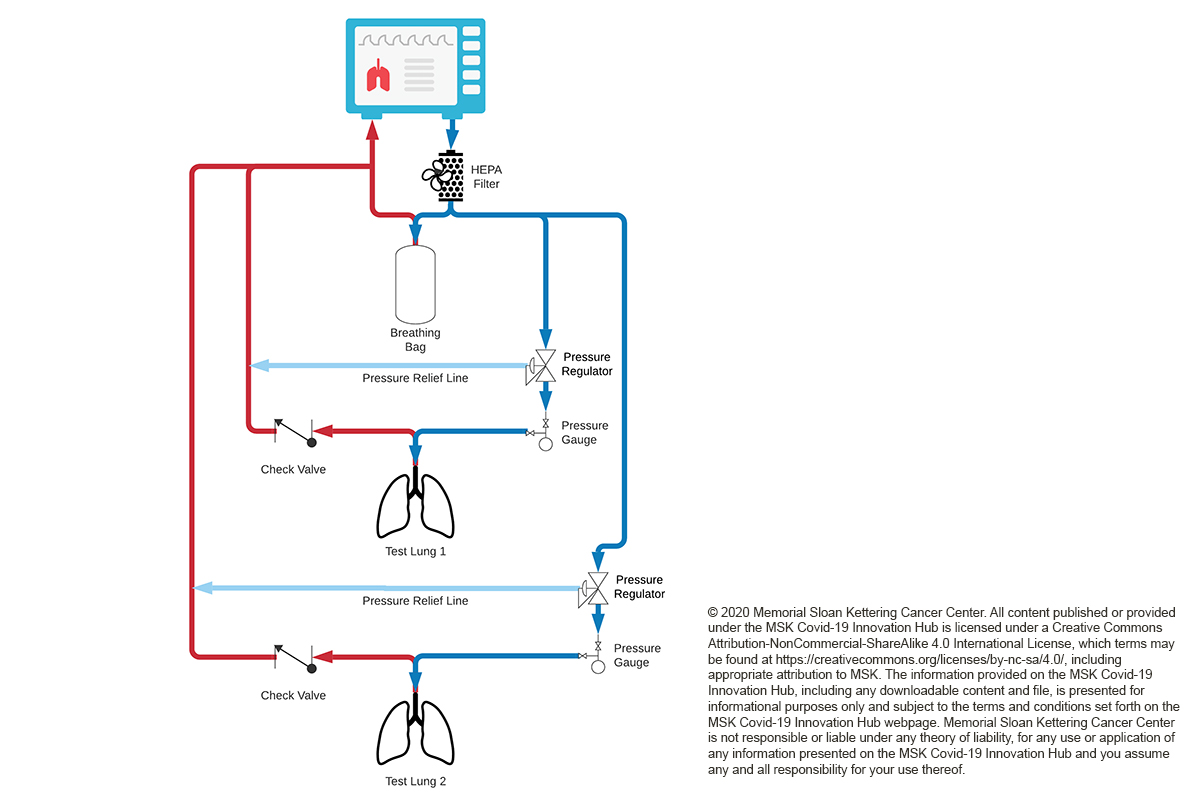Lead Contacts
Samuel Hellman, PhD
Medical Physics
Memorial Sloan Kettering Cancer Center
Grant Chen, MD
Anesthesiology & Critical Care Medicine
Memorial Sloan Kettering Cancer Center
For more information contact
A group of anesthesiologists and biomedical engineers at MSK have developed a novel system that will allow two intubated COVID-19 patients to be simultaneously supported by one mechanical ventilator.
Crucially, the system includes an adjustable pressure regulator added at the inspiratory limb of each patient’s breathing circuit and provides the clinician the ability to independently set the tidal volume for each patient. Additionally, a third flow circuit with a breathing bag is added to the system to allow pressure-equalization and maintain total system flow. The extra circuit allows the ventilator to maintain sufficient flow using elevated pressure while independently down-regulating each patient’s pressure.
One of the critical problems with utilizing a single ventilator for multiple patients during prolonged ventilation has been the inability to compensate for variability in the patients’ size, weight and pulmonary compliances.
Prolonged periods of mechanical ventilation are required when dealing with the COVID-19 population, and our inability to individualize each patient’s tidal volume will eventually lead to ventilator induced lung injury (VILI) and thus jeopardize the survival of both patients. For this reason, numerous national societies have warned against the use of splitting one ventilator for multiple patients.
But this innovative set-up can potentially double the number of ventilators available by superseding the imprecise science used to overcome these variations.
Since we have not yet experienced a ventilator shortage at MSK we have only used the MSK Octopus on test-lungs.
Our invention is intended to be a short-term fix to address the serious lack of ventilators currently being faced as a consequence of the COVID-19 pandemic. It is only for use after hospital administration has approved and acknowledged the unique ethical considerations in a crisis situation such as this.
Contributors
Samuel Hellman, PhD – MSK Medical Physics
Gregory W. Fischer, MD, FASA, Chairman, Anesthesiology and Critical Care Medicine
Robert J Downey, MD – MSK Thoracic Service, Department of Surgery
Grant Chen, MD, Anesthesiology and Critical Care Medicine
Takeshi Irie, MD, PhD, Anesthesiology and Critical Care Medicine
Paul Booth, MS – MSK Biomedical Engineering
Jud Ramaker, MD – MSK Volunteer Retired Technical Supervisor - Respiratory Care Service
MSKCC COVID-19 Innovations Team
Paules CI, Marston HD, Fauci AS. Coronavirus infections—more than just the common cold [published January 23, 2020]. JAMA. doi:10.1001/jama.2020.0757
Wang C, Horby PW, Hayden FG, Gao GF. A novel coronavirus outbreak of global health concern. Lancet 2020; 395: 470–3.
Sorbello M, El-Boghdadly K, Di Giacinto I, Cataldo R, Esposito C, Falcetta S, Merli G, Cortese G, Corso RM, Bressan F, Pintaudi S, Greif R, Donati A, Petrini F. The Italian coronavirus disease 2019 outbreak: recommendations from clinical practice. Anaesthesia. 2020 Mar 27. doi: 10.1111/anae.15049. [Epub ahead of print]
Bhatraju PK, Ghassemieh BJ, Nichols M, Kim R, Jerome KR, Nalla AK, Greninger AL, Pipavath S, Wurfel MM, Evans L, Kritek PA, West TE, Luks A, Gerbino A, Dale CR, Goldman JD, O’Mahony S, Mikacenic C. Covid-19 in Critically Ill Patients in the Seattle Region - Case Series. N Engl J Med. 2020 Mar 30. doi: 10.1056/NEJMoa2004500. [Epub ahead of print]
Lu H, Stratton CW, Tang YW. Outbreak of pneumonia of unknown etiology in Wuhan China: the mystery and the miracle [published January 16, 2020]. J Med Virol. 2020. doi:10.1002/jmv.25678
Wang, D, Hu, B, Hu, C, Zhu, F, Liu, X, Zhang, J, Wang, B, Xiang, H, Cheng, Z, Xiong, Y, Zhao, Y, Li, Y, Wang, X, Peng, Z. Clinical characteristics of 138 hospitalized patients with 2019 novel coronavirus-infected pneumonia in Wuhan, China JAMA 2020 [Epub ahead of print]. 10.1001/jama.2020.1585
Neyman G, Irvin CB. A single ventilator for multiple simulated patients to meet disaster surge. Acad Emerg Med. 2006 Nov;13(11):1246-9.
Paladino L, Silverberg M, Charchaflieh JG, Eason JK, Wright BJ, Palamidessi N, Arquilla B, Sinert R, Manoach S. Increasing ventilator surge capacity in disasters: ventilation of four adult-human-sized sheep on a single ventilator with a modified circuit. Resuscitation. 2008 Apr;77(1):121-6. doi: 10.1016/j.resuscitation.2007.10.016.
Smith R, Brown JM. Simultaneous ventilation of two healthy subjects with a single ventilator. Resuscitation. 2009 Sep;80(9):1087.
Branson RD, Blakeman TC, Robinson BR, Johannigman JA. Use of a single ventilator to support 4 patients: laboratory evaluation of a limited concept. Respir Care. 2012 Mar;57(3):399-403.
Joint Statement on Multiple Patients per Ventilator; American College of Chest Physicians, Society of Critical Care Medicine, American Association for Respiratory Care, American Society of Anesthesiologists, Anesthesia Patient Safety Foundation, American Association of Critical-Care Nurses, and American College of Chest Physicians; Chest. March 26, 2020.




